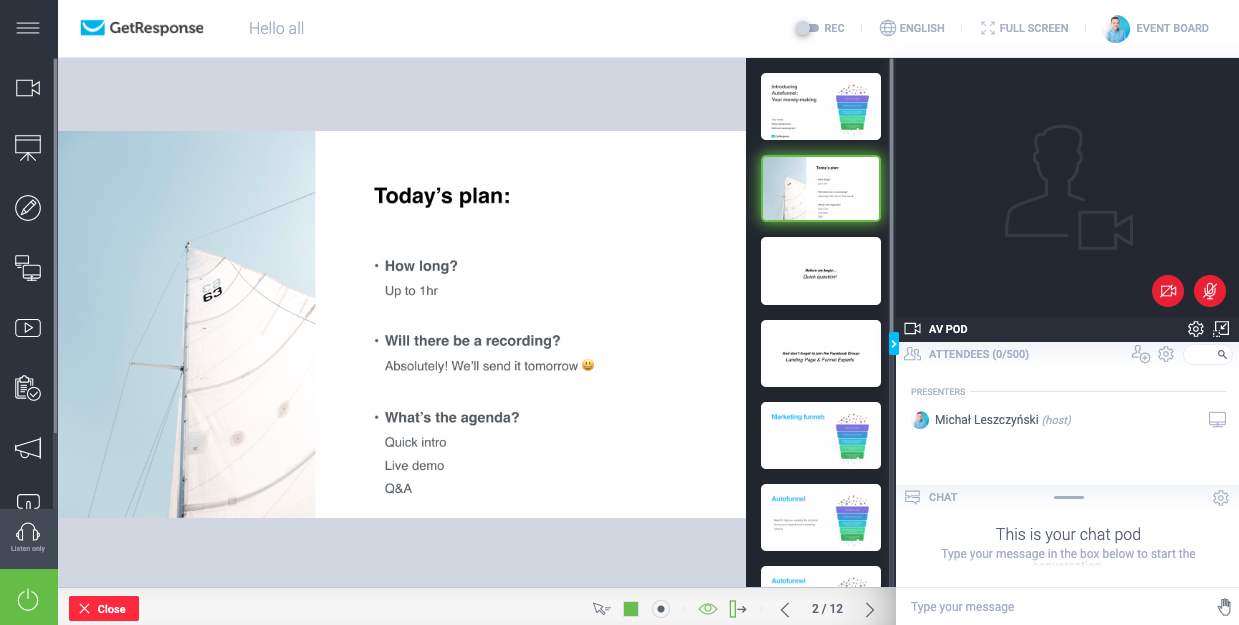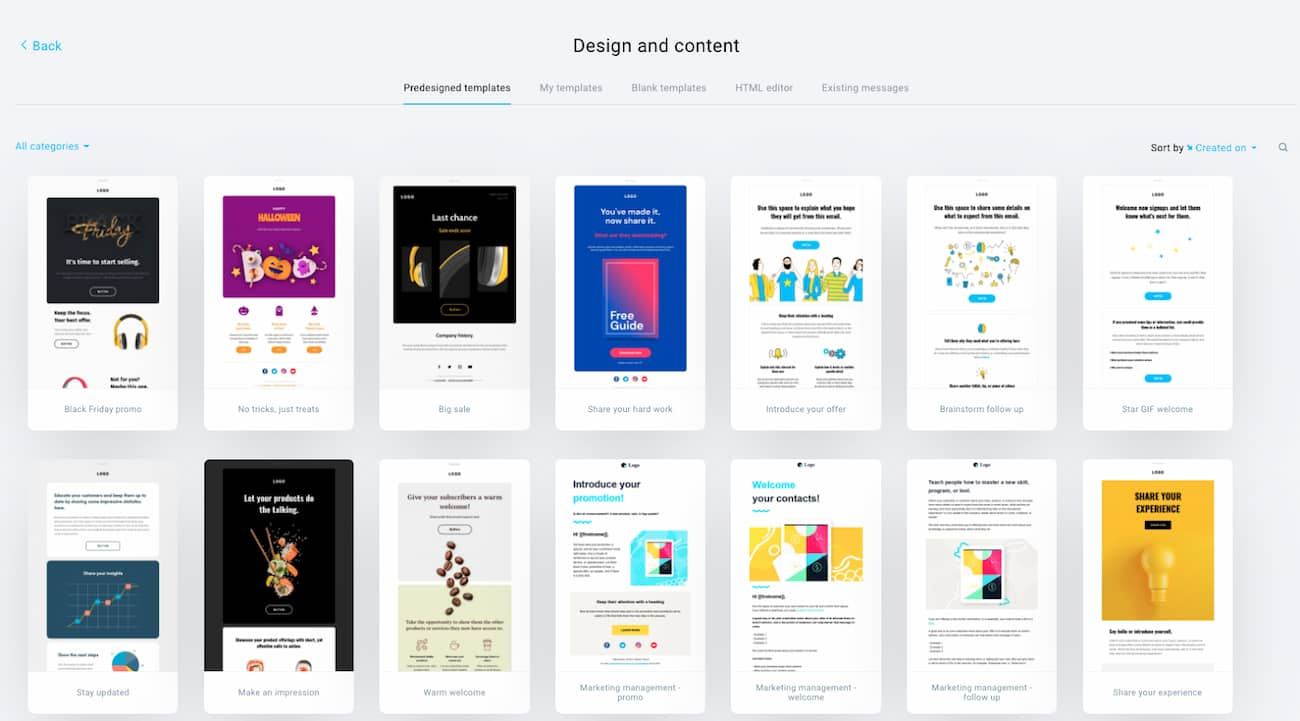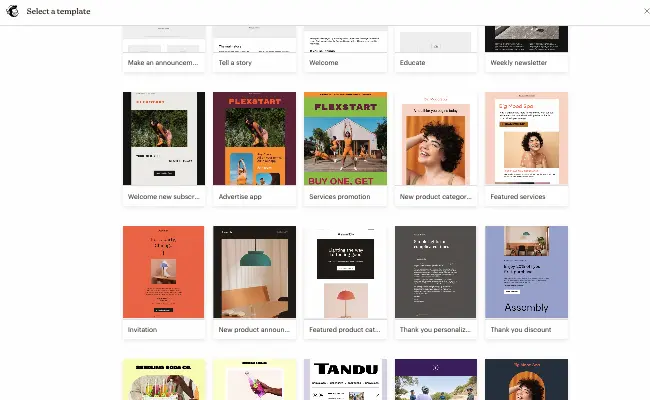Are you a content creator, an artist, a coach, or an SMB owner looking for affordable email newsletter software?
Are you going back and forth trying to figure out if ConvertKit and Mailchimp provide the best solution to your business’ needs?
We can help you decide. We tested both tools and we have a lot to say.
Before we start with our in-depth review, here is the criteria list we used as a guide to cover the most important features in both tools.
- Ease of use landing page builder – What tool offers better pre-designed templates for your specific use case and how easy is it to create a landing page?
- UX and UI design – What tool is user-friendly and easy to navigate?
- Free plan features – What is offered in the Free plan in both email marketing tools?
- Unique features – What tool offers that special something to convert your subscribers into customers?
- Pricing – What happens after you’ve reached the limits of the Free plan?
- Integrations – What tool is better integrated with social and external apps to help you build your audience faster?
While testing these two email marketing tools we ran into some gaps, so we took the liberty to offer a third solution in case that some of the missing pieces in the puzzle could benefit you in the long run.
We will compare ConvertKit and Mailchimp with GetResponse to fill in the blanks and complete the puzzle.
We are not going to name the winner in this email marketing tool truly, the decision is all yours, we are simply offering legit data to help you make the call.
Are you in a hurry? Here’s a quick overview of what features are available in all of the platforms.
ConvertKit vs. Mailchimp vs. GetResponse – key feature comparison
| Feature | ConvertKit | Mailchimp | GetResponse |
|---|---|---|---|
| Email marketing | ✅ | ✅ | ✅ |
| Marketing automation | ✅ | ✅ | ✅ |
| Autoresponders | ❌ | ✅ | ✅ |
| Landing page creator | ✅ | ✅ | ✅ |
| Website builder | ❌ | ✅ | ✅ |
| Signup forms | ✅ | ✅ | ✅ |
| Conversion funnels | ❌ | ❌ | ✅ |
| Web push notifications | ❌ | ❌ | ✅ |
| Webinars | ❌ | ❌ | ✅ |
| Live chats | ❌ | ✅ | ✅ |
| Free plan | ✅ | ✅ | ✅ |
| Lowest plan available | $29/mo | $13/mo | $15/mo |
| Lowest price for 10,000 contacts | $119/mo | $110/mo | $65/mo |
ConvertKit

ConvertKit is an email marketing software dedicated to content creators to help them build an audience and monetize their art.
What we like in ConvertKit:
- Focus on creators – More than 50 million people around the world consider themselves to be content creators. ConvertKit targets this audience by optimizing their messaging and features for their needs.
- Marketing automation tools – ConvertKit features drag and drop builder and pre-build templates for follow-up emails and campaigns.
- Landing pages builder – ConvertKit features a semi-customizable landing page builder. There are some pros and cons to this feature and we will get back to that later, but overall a great option to stand out from the crowd.
- A great option for bloggers – Easy list filtration for sending RSS to a specifically targeted audience works great. ConvertKits’s RSS feed is fully customizable.
- Tagging subscribers – With ConvertKit you can tag your subscribers and set rules for special offers.
What we don’t like in ConvertKit:
- Limited landing page personalization – This feature is purposely limited by ConvertKit. They believe that pre-designed pages have a better chance to convert subscribers into paying customers. You can still change color, images, and text but you can’t move the elements. This feature gets a dislike from us due to limited pre-build options.

Filling the gap: With GetResponse Free Landing Page Builder you can select a pre-designed landing page and customize it entirely:
- You can add blocks for buttons, text, video, or images, and webinars
- Insert pop-up forms
- Add registration forms
- Collect payments via PayPal and other platforms
- Insert social sharing icons
- Preview the page in desktop or mobile version
- A/B test your landing pages
- Integrate your landing page with analytical tools like Google Analytics, Google Tag Manager, etc.
You can choose from tons of pre-designed landing pages to customize or start from scratch.

- You can’t create webinars on the platform – ConvertKit directs you to webinar maker platforms but is not offering this feature as a part of their software. This means if you’re an online creator that wants to build their audience or make money through webinars, you’ll need to invest in an external webinar tool.
Filling the gap: If you are looking to host webinars directly from the platform, GetResponse features Webinar Software.
With GetResponse you can upload your presentation, share screen, use a whiteboard, insert CTAs, add polls, and run an engaging Q/A section. You can also turn your live webinars into on-demand ones and even charge for accessing them – something of particular interest for content creators.
Plus, through Marketing Automation you can not only promote your planned webinars but also follow up on your registrants and attendees automatically after the event ends.

- Web push notifications require external apps – To get notified when someone subscribes or unsubscribes from your list you will have to sign up for the Zapier app. To get notifications you have to be on the purchased plan with ConvertKit.
Filling the gap: GetResponse features Web Push Notifications. Messages are easily customizable and you can even send them automatically based on your audience’s behavior via Marketing Automation.

- Email building templates are extremely limited – Looks like ConvertKit’s philosophy on less is more applies to email templates too. Only nine pre-built email templates are available.

- Their email template editor is also very basic and static. You can change color, fonts, and text. If you want to replace images you will have to download some or use your own – not that we don’t think your images are awesome, we are just wondering what happened with Unsplash integration here.

Filling the gap: GetResponse features an extensive image gallery free for grabs and integrates with Shutterstock and Unsplash. Templates are fully customizable.

Here’s what you can do with the GetResponse’s Email Creator:
- Add blocks for video, text, buttons, and images
- Save created sections
- Add logos, fonts, and colors
- Preview email for dark mode and across different devices
- Customize which content will be invisible on mobile devices
- Customize the order of columns on mobile devices
- Add featured and recommended products
- Spam check for common deliverability issues
Now that we know the pros and cons of ConvertKit let’s look at their pricing.
ConvertKit pricing

First of all kudos for the ConvertKit’s Free plan! This is a great option for content creators who are just getting started with their email marketing.
This plan is available for up to 1000 subscribers. It is fairly limited in advanced features but by looking into their Creator plan you don’t get much for $29/mo either.
Automated funnels and free migration from another platform are the only additions to the Creator plan.
For more advanced features you will have to pay $59/mo and this still counts for up to 1000 subscribers. The good thing is that you can test all the plans for 30 days.
Filling the gap: GetResponse offers a better deal for a lower price.

The Free plan lets you store up to 500 contacts, send newsletters, and build your online presence via website or landing page.
The Email marketing package is $15/mo for the list of 1000 contacts (billed annually). This includes email marketing, autoresponders, forms and popups, 1 landing page, 1 website, and Facebook ads.
Marketing automation builder, automated tagging and scoring, webinars, sales funnels, and other automation-focused features are available in the Marketing automation plan that starts at $49 per month.
The Ecommerce marketing plan starts at $99 p/m and comes with ecommerce-focused features like ecommerce automation workflows, quick transactional emails, ecommerce segmentation, promo codes, web push notifications.
Sign up to GetResponse completely free and get 30-day access to its premium features. No credit card required.
Pro tip: GetResponse also offers several discounts – 18% off when you choose an annual plan, 30% off for a biannual plan, and 50% off for nonprofits.
Moving on to good old Mailchimp.
Read more related content:
1. GetResponse vs. ConvertKit: Here’s What You Should Know!
2. 10 Best Mailchimp Alternatives
Mailchimp

Mailchimp grew from a simple email marketing software to an all-around marketing solution.
Let’s jump right into the pros and cons to avoid spoilers.
What we like in Mailchimp:
- It is simple to use – Starting with the sign-up button up to drag and drop template builder Mailchimp’s interface is user-friendly.
- Integrations with external apps – Mailchimp is a well-integrated email marketing platform, featuring integrations with 250+ apps amongst which are popular social apps.
- Free plan – Just like ConvertKit, Mailchimp offers a free plan, it is limited in features but it is a great option to build an audience.
What we don’t like in Mailchimp:
- Plans and pricing – Mailchimp used to offer a generous free plan, but since its acquisition by Intuit, it became more limited. In addition, its paid plans also got more expensive, especially compared to other alternatives.
- Additional charges if you send more frequently – Unlike some other platforms, Mailchimp doesn’t offer unlimited sending to your contacts. So prepare to pay extra if you cross Mailchimp’s limitations.
Filling the gap: GetResponse offers unlimited email sending in all its paid plans.
- Outdated email templates – Pre-designed templates available to the free users are surprisingly outdated and hard to customize with their classic email builder. Plus, there are no free images included in the account, so you’ll have to design or upload your own.

- Email templates – Mailchimp’s new email editor is easier to use and now offers 100+ email templates. Unfortunately, to access them you’ll need to upgrade to their paid plan.

Filling the gap: GetResponse Email Creator comes with completely free, stunning, and fully customizable email templates. You also have a full image gallery and a built-in image editor you can use to further polish your designs. Plus, thanks to features like Inbox preview and mobile preview, you’ll have the extra layer of confidence that your emails will look good in your recipients’ inboxes.
- Hard to use if you have multiple lists – if you want to send the message to multiple lists you’ll have to do that individually, several times. Otherwise, you’ll be risking emailing the same contacts multiple times as Mailchimp doesn’t check for duplicates before delivering your message.
Filling the gap: GetResponse automatically checks for duplicates if you send to multiple lists or segments at the same time.
- Few landing page templates – Although their drag and drop editor is pretty intuitive, it only comes with a handful of landing page templates. And since they’re so limited, you can’t filter them based on your business or campaign goals.

- Limitations in the landing page builder – The landing page builder offers a free generic URL but if you’d like to use your custom domain, you’ll have to pay for that extra. Plus, you can’t A/B test your landing pages or integrate with other platforms like Google Analytics or Hotjar.
Filling the gap: GetResponse lets you assign your own custom domain free of charge. Plus, it also lets you integrate with external platforms like Google Analytics, Google Tag Manager, or Facebook.
Mailchimp pricing

The prices presented are for only 500 contacts., let’s look at the features offered in these plans.
Essentials plan is an email-only send plan. Advanced automation and integrations are not featured. It costs $13/mo unless you exceed the limits.
The Standard plan is $20/mo. It includes more automation-oriented features, along with audience-building features like their form builder or CRM. However, you can’t do advanced segmentation or A/B test your automation workflows on this plan.
Unfortunately, its calculator is not optimized for 1000+ contact lists, so we selected the closest option to present the pricing for the Essentials plan. It will cost you $26.5/mo to only send emails for up to 1500 contacts.
Filling the gap: GetResponse’s Standard plan is $15/mo for the list of 1000 contacts with autoresponders, sales funnel, Facebook ads, and more. Sign up free today. Plus, you can get an 18%-30% discount if you opt in for a longer-term contract.
ConvertKit vs. Mailchimp unique features
What is so special about these tools? We will try to answer this by analyzing unique features that bring results.
ConvertKit vs. Mailchimp – marketing automation
ConvertKit offers a range of marketing automation tools. It features pre-built templates to help you keep everything in sight.
It also features a drag-and-drop builder for follow-up emails and marketing campaigns.

Convertkit.com
Mailchimp also features automation but your ability to set these depends on your chosen plans. In a Standard plan, you can set up customers’ journeys and set time optimizations. All advanced automations are reserved for the Premium plan.
Filling the gap: With GetResponse you can choose from pre-built marketing automation workflow templates – which you can customize – or build them completely from scratch. Depending on your automation needs, a drag and drop builder is available to help you stay on track in your workflow.
Here’s an example for abandoned cart automation:

ConvertKit vs. Mailchimp – A/B testing
With ConvertKit you can simply test your subject lines, however, you are not in control of the email sending percentage. For example, your winning subject line will be sent to 70% of your contacts. The results of the campaign might be misleading.
With Mailchimp, you won’t have this feature available in the Free plan.
Filling the gap: If you are looking for an email marketing tool that features A/B testing for more than two subject lines or email content at once, and need automated sending of the winner line to your list then GetResponse is a better option. These tests will help you better understand how your campaign is doing and what needs to be improved.

ConvertKit vs. Mailchimp – integrations
Mailchimp is a better-integrated tool, however, the ability to use the most out of these will depend on the plan selected.
ConvertKit lacks integrations with major software like Canva and PayPal but they do provide API instructions on how to connect with external apps.
Filling the gap: If you are an entrepreneur or content creator looking for an email marketing tool that seamlessly integrates with video, social apps, or lead generation tools then you might consider GetResponse.
GetResponse features integrations with Facebook, Twitter, YouTube, Vimeo, and many other apps that will help you promote your content, and if you are selling your art, integrations with online stores in one click of a button away. It also offers built-in Google and Facebook Ads that’ll help you promote your business with ease.

ConvertKit vs. Mailchimp – customer support
What if you hit a wall when trying to build your email marketing campaign?
Mailchimp offers 24/7 support via email. If you prefer phone support you won’t get it, unless you are on their Premium plan.
ConvertKit email and chat are available from 8 AM to 8 PM ET, 5 days a week. They rely on peer-peer support on their available channels.
But what happens if you are not a native English speaker?
You would have to imagine a grasshopper chirping sound here. Both platforms are available only in English.
Filling the gap: GetResponse offers 24/7 support via email and chat. Email support is available in eight languages.

ConvertKit vs. Mailchimp vs. GetResponse Scores
| Feature | Mailchimp | Convertkit | GetResponse |
|---|---|---|---|
| Email templates builder | 3 | 3.5 | 4.8 |
| Ease of building a landing page | 3 | 3.5 | 4.9 |
| Tracking and analytics | 3 | 3.8 | 4.9 |
| Customer support | 4 | 3 | 5 |
| Marketing Automation | 3 | 4 | 4.7 |
| Ease of use | 4 | 5 | 4.8 |
| Pricing | 3 | 4 | 5 |
| Total score | 3.3/5 | 3.8/5 | 4.8/5 |
ConvertKit vs. Mailchimp vs. GetResponse. Which Is the Perfect Tool for You?
As you saw from this in-depth review, answering this question is no easy task.
The answer will largely depend on your needs in terms of features, integrations, and the tool’s ease of use. And of course, your budget constraints.
Would you like to read about more comparisons? Check out how GetResponse and Mailchimp compare to another popular email marketing solution – AWeber! Continue reading
If you’re looking for the most versatile and affordable tool within this comparison, then GetResponse should be your pick.
GetResponse offers a free plan that lets you build your online presence, attract new subscribers, and send newsletters with its unlimited email creator.
And as you grow and start needing more tools, be it webinars, marketing automation, web push notifications, or SMS – you can pick any of our paid plans.
So why not take the first step, and sign up for free right away?
Author’s note: This comparison is accurate on November 30, 2023. We do our best to keep it as accurate as possible, and we check it on a regular basis, however, if you want to acquaint yourself with the offer of our competitors, you should check it at their official website or contact their representatives.